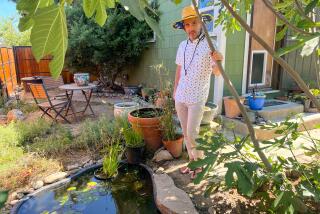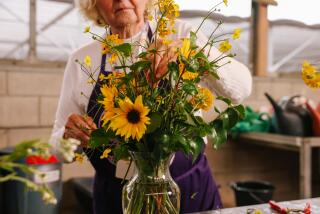Gardening : Bird’s-Nest Fern Not Easy to Grow Inside
- Share via
QUESTION: I love the look of bird’s-nest ferns, but they always turn brown around the edges soon after I bring them home. Is it possible to grow them indoors?
ANSWER: I love bird’s-nest ferns, too, and it’s possible--but not easy--to grow them indoors. (Outdoors, in our Southern California climate, they’ll grow big enough to house a family of ostriches!) Your best bet is to provide your plant with lots and lots of humidity and keep it out of direct sunlight.
Brightly Colored Plants Require Sun
Q: Why is it so hard for me to keep plants with brightly colored foliage, such as crotons, alive? I have very good luck with all my “regular” plants.
A: The colorful, variegated plants don’t have as much chlorophyll in their leaves as the “regular” green foliage plants, and since chlorophyll helps build a plant’s strength, that’s the problem. Keep your brightly colored plants and your flowering plants in bright, sunny spots--that should help prolong their lives.
New Rosary Vines Can Be Grown From Bulbs
Q: I’ve had a rosary vine for a couple of years, and this summer I noticed it had bloomed--little purple flowers--and small bulbs have formed along the stem. Can I propagate new plants from these bulbs or are they just “decoration”?
A: Yes, you can propagate new rosary vines (Ceropegia woodii) from those little bulbs, or bulbils as they are known botanically. And congratulations on the flowers!
Don’t Be Afraid to Try Growing Orchids
Q: I’m dying to try growing an orchid plant, but they’re so expensive I’m afraid of failure. Are there any orchids that will absolutely, positively bloom in the house?
A: I can’t absolutely, positively guarantee anything--houseplants are living things, after all, and can be temperamental and unpredictable. But don’t be afraid of trying an orchid. There are several species that will do very well indoors--Cattleyas, Cymbidiums, Dendrobiums and Phaelaenopsis foremost among them.
The most important factor in raising orchids is to make sure you buy one of the above and have exact directions for cultivating it. I’d suggest you buy your first orchid at Stewart’s Orchids, 3838 Sepulveda Blvd., in Culver City. They have an excellent selection, knowledgeable salespeople--and you might even get a very good price on a healthy plant that’s not blooming at present.
Air-Layering Can Turn One Plant Into Two
Q: I have a dieffenbachia that’s about six-feet tall but there’s only a tuft of leaves at the top and I hate the way it looks. Somebody told me I should “air layer” it. What’s that mean, and should I?
A: Why not? Air-layering is a relatively easy propagating technique that’s used on woody or thick-stemmed plants like dracaenas and dieffenbachias and will enable you to have two plants (or more) that you’ll love from the one you hate!
Here’s how to do it: Pick a spot as far down or as near to the top of your plant as is aesthetically pleasing to you--but at least six inches below the lowest leaves or leaf buds. This will be the base of your new plant. Then, using a single-edged razor blade or very sharp knife, cut a notch in the side of the trunk, being careful not to go all the way through to the back of the stem.
Place a piece of toothpick or wooden matchstick into the notch to keep it open, then wrap damp spaghnum moss around the notch, wrap a plastic baggie or plastic wrap around that, and then secure it with a twist ‘em or plant tie. Every three or four days remove the plastic, spray the moss to keep it damp, and replace the plastic.
Within about three weeks roots will have grown from the notch in the trunk. Now cut the trunk about an inch below the rooted notch. Plant the part of the plant that you’ve removed into a six-inch-diameter pot filled with fresh potting soil.
The original stem remaining in the first pot can be cultivated as before, and soon, new shoots will emerge from either side of the stem and eventually form a new plant. (If the stem or cane that remains is too long for your taste, it can be cut up into six-inch-long pieces that can be individually rooted in vermiculite or water.)






